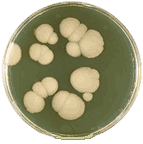Papers in the Biological Sciences
Document Type
Article
Date of this Version
2011
Citation
Microbiology (2011), 157, pp. 270–279. DOI 10.1099/mic.0.045005-0 270 045005
Abstract
Hemiascomycetes, including the pathogen Candida albicans, acquire nitrogen from urea using the urea amidolyase Dur1,2, whereas all other higher fungi use primarily the nickel-containing urease. Urea metabolism via Dur1,2 is important for resistance to innate host immunity in C. albicans infections. To further characterize urea metabolism in C. albicans we examined the function of seven putative urea transporters. Gene disruption established that Dur3, encoded by orf 19.781, is the predominant transporter. [14C]Urea uptake was energy-dependent and decreased approximately sevenfold in a dur3D mutant. DUR1,2 and DUR3 expression was strongly induced by urea, whereas the other putative transporter genes were induced less than twofold. Immediate induction of DUR3 by urea was independent of its metabolism via Dur1,2, but further slow induction of DUR3 required the Dur1,2 pathway. We investigated the role of the GATA transcription factors Gat1 and Gln3 in DUR1,2 and DUR3 expression. Urea induction of DUR1,2 was reduced in a gat1D mutant, strongly reduced in a gln3D mutant, and abolished in a gat1D gln3D double mutant. In contrast, DUR3 induction by urea was preserved in both single mutants but reduced in the double mutant, suggesting that additional signalling mechanisms regulate DUR3 expression. These results establish Dur3 as the major urea transporter in C. albicans and provide additional insights into the control of urea utilization by this pathogen.
Included in
Environmental Microbiology and Microbial Ecology Commons, Other Life Sciences Commons, Pathogenic Microbiology Commons



Comments
U. S. government work.